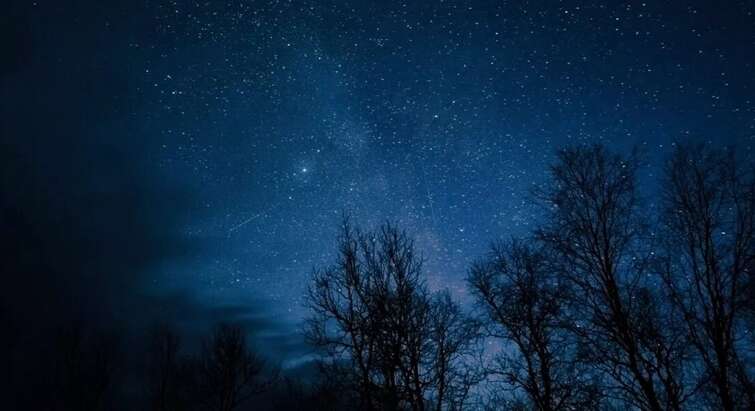

Research at DAWN
DAWN's research is focused on the specific period in the history of the Universe known as Cosmic Dawn. This previously unexplored period, 300-600 million years after the big bang is when the first stars, black holes and galaxies are believed to have formed.
The Cosmic Dawn Center is involved in a number of observational surveys, utilizing multiple instruments and telescopes. The abundant data emerging from these tools is analyzed through both theoretical models and numerical simulations.
We study the birth, life, and death of galaxies. Additionally, we study the smaller scales, namely the gas and dust that lies in between the galaxies' stars — the interstellar medium — and the larger scales, namely the effect that the galaxies have on their environment in the early Universe; the so-called Epoch of Reionization.
Research Themes:
First Galaxies
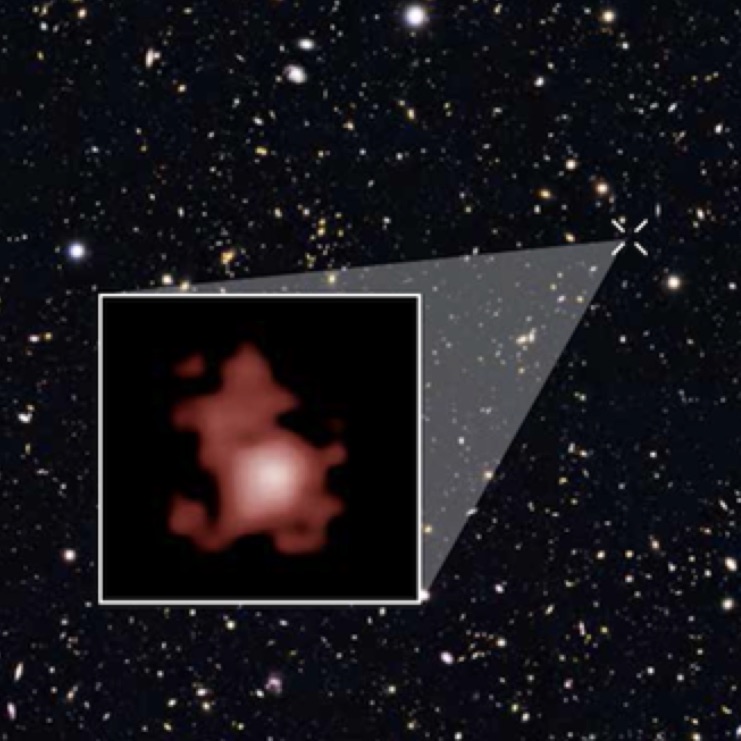 Galaxies are the building blocks of the Universe, and understanding how, and how soon, these enigmatic structures of gas, stars, and dark matter arose, is an observationally challenging task, since it involves detecting the faintest sources, almost at the edge of the observable Universe.
Galaxies are the building blocks of the Universe, and understanding how, and how soon, these enigmatic structures of gas, stars, and dark matter arose, is an observationally challenging task, since it involves detecting the faintest sources, almost at the edge of the observable Universe.
The currently most distant — and hence earliest — galaxy is seen at an epoch where the Universe was only 400 million years old, 3% of its current age. The first stars were formed at half this age, but have not yet been observed directly.
DAWN is involved in the James Webb Space Telescope (JWST), which was launched in December 2021, providing unprecedented deep exposures of some of the very first galaxies and protogalaxies.
Galaxy evolution
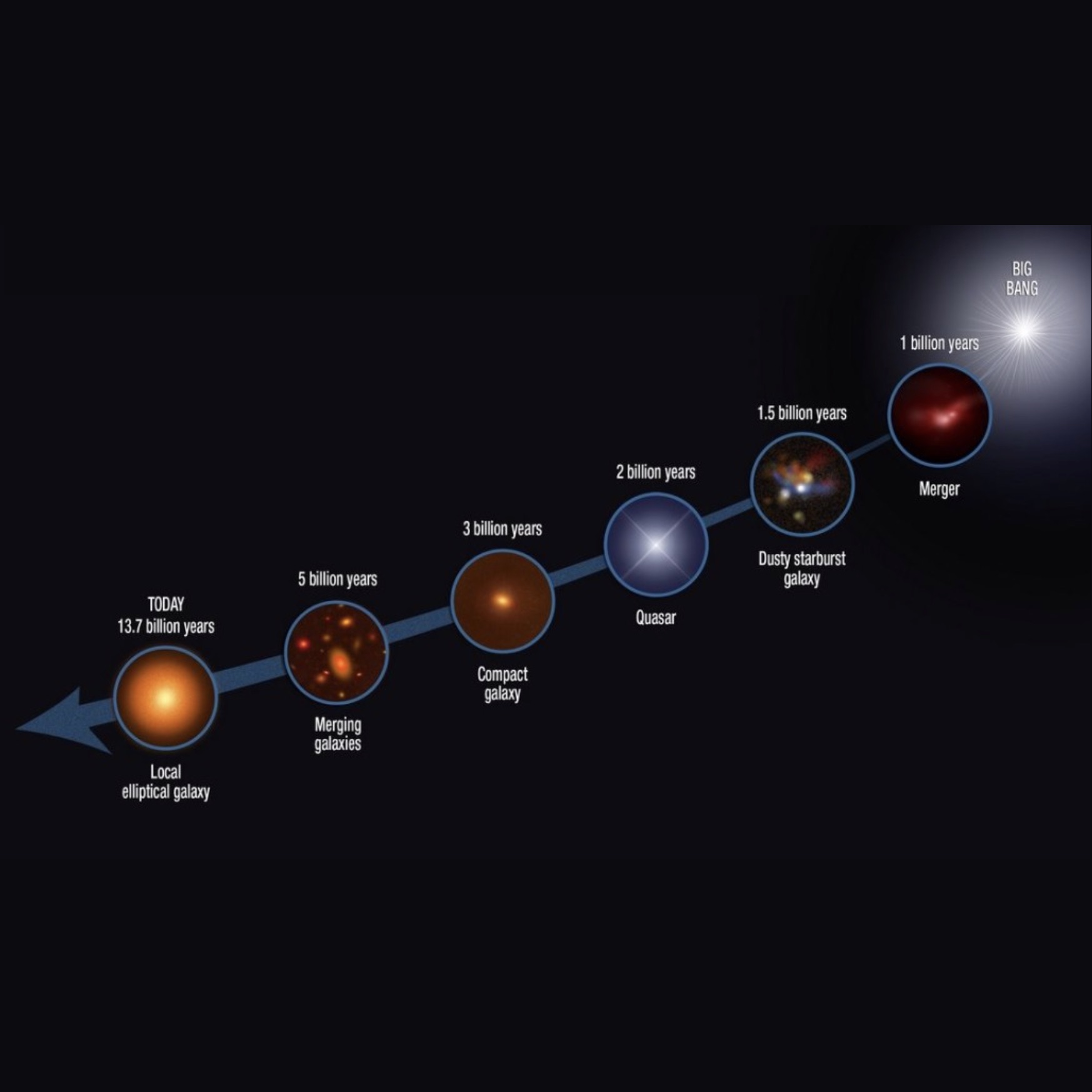 Galaxies evolve through both internal and external processes: Gas is converted to stars which pollute the interstellar medium with heavy elements, some of which form dust grains. Spiral arms form, and gas is ejected as galactic winds, triggered by the feedback of stars and quasars. At the same time, galaxies accrete new gas from the intergalactic medium, and merge with other galaxies.
Galaxies evolve through both internal and external processes: Gas is converted to stars which pollute the interstellar medium with heavy elements, some of which form dust grains. Spiral arms form, and gas is ejected as galactic winds, triggered by the feedback of stars and quasars. At the same time, galaxies accrete new gas from the intergalactic medium, and merge with other galaxies.
The interplay between these processes determines the fate of a galaxy — whether it will turn out a flat and star-forming spiral galaxy, an elliptical, red and "dead" galaxy, or something else.
The evolution takes place over timescales of hundreds of millions of years, and hence cannot be observed "live". But studying the statistical properties of large samples of galaxy populations through observational surveys and theoretical modeling, DAWN continuously contributes to expand our cosmological horizon.
Quenching
Some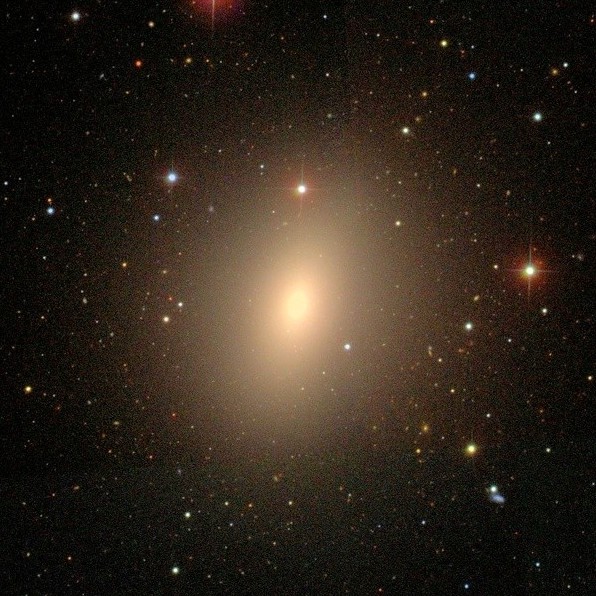 galaxies continue to form stars from the time they are formed and until today. The beautiful bluish spiral galaxies are an example of this. However, others — typically the most massive and elliptical galaxies — at some point cease to form stars. As the short-lived, blue stars die out and the long-lived, red ones remain, these galaxies get their characteristic orange-reddish color.
galaxies continue to form stars from the time they are formed and until today. The beautiful bluish spiral galaxies are an example of this. However, others — typically the most massive and elliptical galaxies — at some point cease to form stars. As the short-lived, blue stars die out and the long-lived, red ones remain, these galaxies get their characteristic orange-reddish color.
What is the cause of this so-called
The interstellar medium
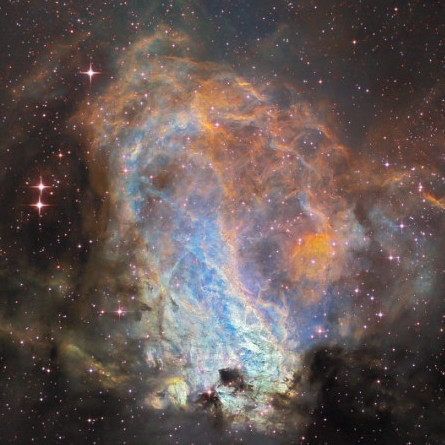 Whether stars die with a whimper or with a bang, they return their gas to the space in between them, only now it is polluted with heavier elements, or
Whether stars die with a whimper or with a bang, they return their gas to the space in between them, only now it is polluted with heavier elements, or
These elements are important in several ways: Not only the metals themselves, but also the molecules and the dust that they form, affect observations both in emission and in absorption. Acting as a coolant, they facilitate star formation, and through the many electronic transitions of metals and molecules and the large cross sections of dust grains they engender massive outflows through stellar and galactic winds.
These processes are interesting in themselves, but also have major impacts on the evolution of galaxies. Analyzing the interstellar medium is thus pivotal to understand galaxies. Notably, DAWN searches for signatures of some of the first molecules to form, such as carbon monoxide.
Reionization
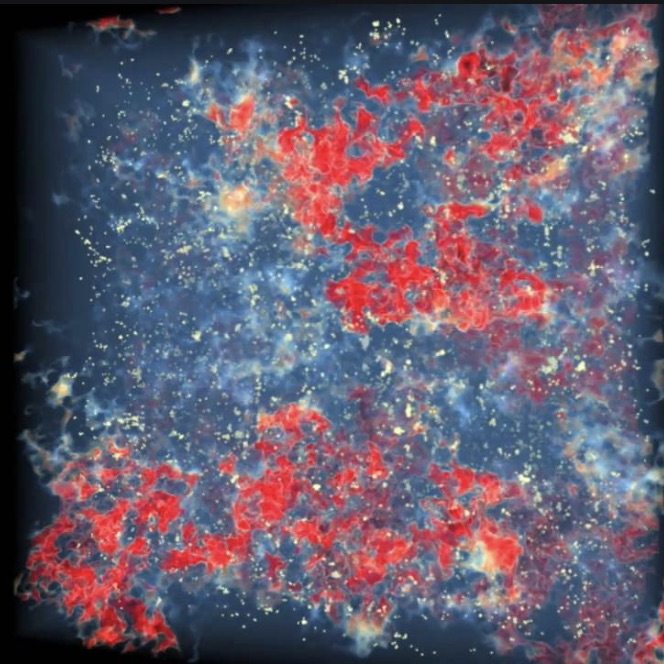 In addition to all the action happening in the Universe in the form of planets forming, stars exploding, galaxies forming, etc., through its history the Universe has also experienced a number of global transitions. Most of these took place in the early Universe, in particular during the Big Bang.
In addition to all the action happening in the Universe in the form of planets forming, stars exploding, galaxies forming, etc., through its history the Universe has also experienced a number of global transitions. Most of these took place in the early Universe, in particular during the Big Bang.
When the Universe had cooled enough that neutral atoms could form, it remained neutral for several hundred millions of years. However, roughly half a billion years after the Big Bang, a global phase transition took place, where the entire vast space between the galaxies was re-ionized.
The sources of the ionizing radiation was probably hot stars in the first galaxies, but quasars also played a role. The transition was fast, cosmologically speaking, but exactly how did it progress? And how clumpy was the reionization? Before the epoch of reionization, light from galaxies has a hard time traveling through the Universe, but if reionization happened in a percolative manner, with large ionized bubbles around some galaxies, these may still be detected. DAWN investigates this interesting epoch in particular through numerical simulations.
Instruments
James Webb Space Telescope:
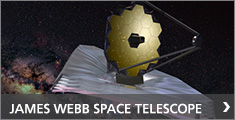 With a planned launch in 2021, the James Webb Space Telescope (JWST) is designed to study the stars and gas in the first galaxies. JWST primary mirror is 6.5 m in diameter, and it is equipped with 4 infrared instruments for imaging and spectroscopy. DAWN scientists have partaken in the construction of three of these instruments (NIRSpec, MIRI and NIRISS), and will be involved in the analysis of the first data from the telescope. Check out more at https://jwst.nasa.gov/index.html.
With a planned launch in 2021, the James Webb Space Telescope (JWST) is designed to study the stars and gas in the first galaxies. JWST primary mirror is 6.5 m in diameter, and it is equipped with 4 infrared instruments for imaging and spectroscopy. DAWN scientists have partaken in the construction of three of these instruments (NIRSpec, MIRI and NIRISS), and will be involved in the analysis of the first data from the telescope. Check out more at https://jwst.nasa.gov/index.html.
Atacama Large Millimeter Array (ALMA):
 ALMA is the worlds largest radio telescope, located on the Chajnantor Plateau in the Atacama Desert in Chile, one of the highest and driest places on Earth.
ALMA is the worlds largest radio telescope, located on the Chajnantor Plateau in the Atacama Desert in Chile, one of the highest and driest places on Earth.
Astronomers at DAWN use ALMA to study the emission lines and continuum from the cold and dusty environments that compose the interstellar medium (ISM). The reason behind this is the fact the molecular hydrogen - a fuel for star formation, can only exist in these cold regions of the galaxy. The investigation of these environments is complimentary to the study of hot gas and stellar emission and is imperative in furthering our understanding of galaxy evolution.
The telescope is composed of 66 high precision antennae, each with a diameter of 12m, which act together as a single telescope. ALMA is designed to observe emission from cold dust and gas in the early Universe, complementing JWSTs observations of the hot gas and stars in the first galaxies. For more information check out http://www.almaobservatory.org/
Euclid mission:
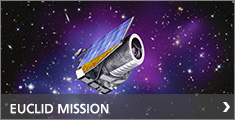 Following its launch in 2020, the ESA/Euclid mission will map out a large part of the sky, with the primary goal of constraining the nature of Dark energy. As part of its calibration plan, Euclid will observe 40 square degrees to great depth, the so-called Euclid Deep Fields. These fields will be a treasure trove for finding rare, bright early galaxies. DAWN scientists play a leading role in the exploration of these deep fields, and will have early access to samples of early galaxies for follow up observations with JWST and ALMA. Read more about Euclid at http://sci.esa.int/euclid/.
Following its launch in 2020, the ESA/Euclid mission will map out a large part of the sky, with the primary goal of constraining the nature of Dark energy. As part of its calibration plan, Euclid will observe 40 square degrees to great depth, the so-called Euclid Deep Fields. These fields will be a treasure trove for finding rare, bright early galaxies. DAWN scientists play a leading role in the exploration of these deep fields, and will have early access to samples of early galaxies for follow up observations with JWST and ALMA. Read more about Euclid at http://sci.esa.int/euclid/.
Supporting extragalactic surveys:
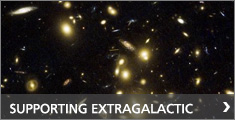 In addition to Euclid, DAWN scientists are involved in a number of the largest existing extragalactic surveys, which will be important sources of targets for JWST and ALMA. These include the COSMOS survey, the Hubble Frontier Field survey, Buffalo, 3DHST, SMUVS, Ultravista and Splash.
In addition to Euclid, DAWN scientists are involved in a number of the largest existing extragalactic surveys, which will be important sources of targets for JWST and ALMA. These include the COSMOS survey, the Hubble Frontier Field survey, Buffalo, 3DHST, SMUVS, Ultravista and Splash.
COSMOS: http://cosmos.astro.caltech.edu/
Hubble Frontier Field: http://www.stsci.edu/hst/campaigns/frontier-fields/HST-Survey
Buffalo: https://buffalo.ipac.caltech.edu/
3DHST: https://3dhst.research.yale.edu/Home.html
SMUVS: https://irsa.ipac.caltech.edu/data/SPITZER/SMUVS/overview.html
Ultravista: http://ultravista.org/
Splash: http://splash-survey.org/
News


